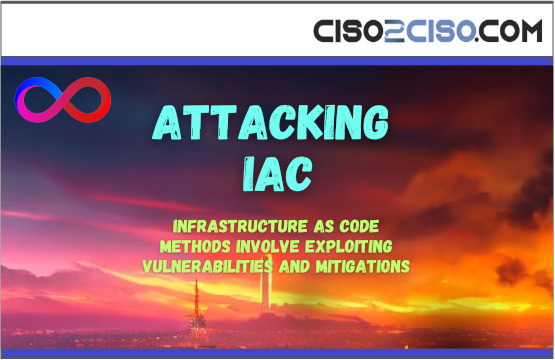INFRASTRUCTURE AS CODE METHODS INVOLVE EXPLOITING VULNERABILITIES AND MITIGATIONS
The document “Attacking Infrastructure as Code (IaC)” outlines various methods of securing and mitigating risks in Infrastructure as Code (IaC) environments, with a particular focus on Terraform. IaC allows developers to automate the provisioning and management of IT infrastructure using code. However, if not properly secured, these automation scripts can introduce security vulnerabilities. The key sections in the document include:
Least Privilege
The principle of least privilege ensures that users or processes have the minimum access rights necessary. This can be applied to IaC environments by implementing Role-Based Access Control (RBAC) and using Terraform workspaces to segregate environments.
Secrets Management
Storing sensitive data such as API keys or passwords in Terraform configurations presents significant security risks. The document advises against hardcoding secrets and suggests using environment variables or secrets management tools like HashiCorp Vault to securely handle secrets.
Encryption of Sensitive Data
Encryption of sensitive data is critical to protecting it from unauthorized access. Using Key Management Services (KMS) like AWS KMS or Azure Key Vault, and PGP (Pretty Good Privacy), helps ensure that sensitive information remains secure.
Compliance as Code
The document emphasizes that security policies for encryption, access control, logging, and monitoring should be implemented as code. This ensures compliance with security standards across cloud-native applications.
Terraform Plan and Apply
Before making changes to infrastructure, the terraform plan command provides a preview of what will happen. It is crucial to review these changes for security risks before executing them with terraform apply.
Malicious Providers or Modules
IaC configurations might include third-party providers or modules, which could be malicious. The document advises using trusted sources and pinning versions to avoid vulnerabilities.
Isolation and Logging
Using separate Terraform workspaces for different environments ensures that one environment does not affect another. Securing Terraform logs is also important, as logs may contain sensitive data, including passwords or API keys.
Dynamic Credentials
To reduce the risk of exposing long-lived credentials, the document recommends using dynamic credentials, which are temporary and expire after a certain period.
Conclusion
The document concludes by stressing that IaC, while useful for automating infrastructure, must be secured through practices like limiting permissions, securing secrets, encrypting sensitive data, and isolating workspaces. These best practices help protect infrastructure from being compromised by malicious actors.
In summary, the document provides a comprehensive guide to protecting IaC environments, with detailed examples of securing Terraform configurations, managing secrets, encrypting data, and mitigating risks posed by malicious modules or providers.
Views: 3




















































